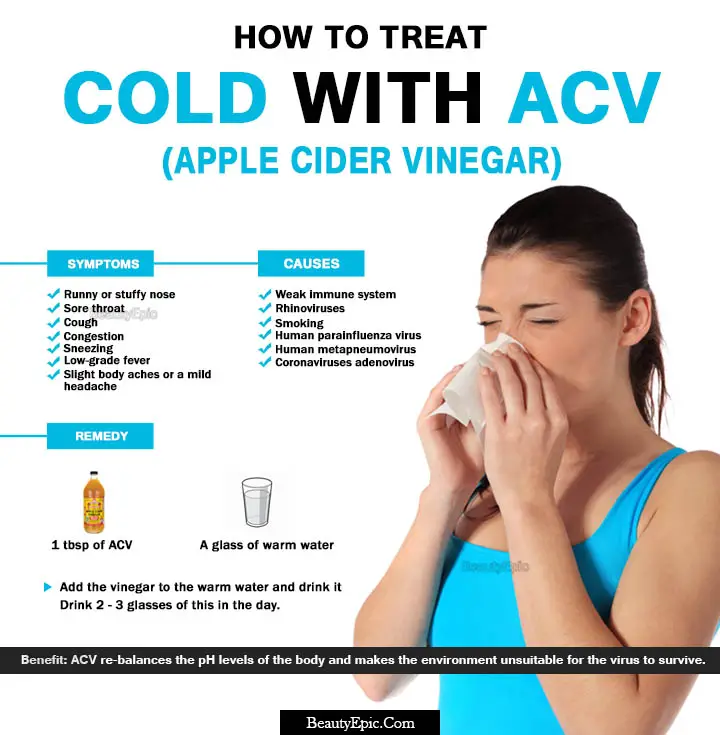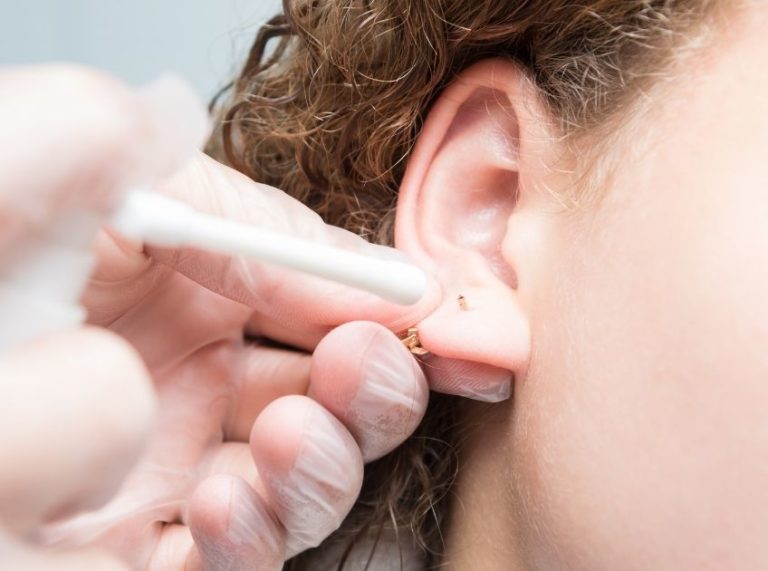
Important: This article is for informational purposes only. Please read our full disclaimer for more details.
A runny nose, rough throat, and continuous sneezing- you can’t overlook the signs of a cold. Have you ever thought, why do you seem to get cold so often while your close friend stays well? Mystery envelops a lot of other things about it. Cold is communicable from the person who is infected with the virus. This illness usually happens when you touch surface that has bacteria on it and then comes in contact with your nose and mouth. A healthy person can also catch it if someone sneezes into the air. The cold begins when the virus gets attached to the lining of the nose and throat. Here we discussed some best ways to use apple cider vinegar for colds.
Does Apple Cider Vinegar Cure a Cold?

- ACV helps in cleaning ablocked nose. Drinking it in diluted form can help to break the mucus.
- It contains a heavy amount of minerals like Potassium, calcium, iron and magnesium which helps to cure cold and cough, thus acting as a natural medicine.(1)
- It fights infection due to anti- infective quality.
- It regulates the body’s pH level thus reducing the risk of illness.
- It is filled with Vitamins and boosting acetic acid which act as ultimate medication to cure a cold.
How to Use Apple Cider Vinegar for Colds?
Apple cider vinegar or ACV is pretty marvellous stuff. But did you know how it can be beneficial in preventing cold and flu? Instead of using cough syrups and mind-numbing medicines try these natural remedies for curing a cold with ACV.
1. Apple Cider Vinegar and Water for Cold
- Drink the apple cider vinegar in the initial stage of the infection.
- Mix 2 tablespoon of apple cider vinegar in a glass of water and drink it
- Repeat the above steps daily.
2. Apple Cider Vinegar in Vaporizer for Cold
- Add few drops of ACV in the vaporizer;
- this process relieves the person from the flu, cold and infections.
3. Apple Cider Vinegar with Garlic for Cold
- To the blender, add 8 cloves of garlic and 1 cup apple cider vinegar with 1 cup of honey
- Blend it well, pour mixture into another container and keep it in refrigerator
- Add 2 teaspoon of mixture in the glass and drink daily on an empty stomach till you find relief from cold.(2)
[ Read: How to Use Garlic for Cold? ]
4. Apple Cider Vinegar with Black Pepper for Cold
- Cut a piece of cloth and soak the cloth for 10 minutes in the apple cider vinegar
- Sprinkle Black Pepper on one side of the cloth
- Lay across the chest for half an hour and rise off the water it will provide relief from the chest congestion.
- Repeat this process two times a day.
5. Apple Cider Vinegar with Lemon and Cayenne Pepper for Cold
- Boil a ¼ cup of water.
- After removing from flame add ¼ cup of Apple cider vinegar.
- Pour into mug and add 1 tablespoon of lemon, honey, and cayenne pepper
- Drink it and repeat the process daily.
6. Apple Cider Vinegar with Honey for Cold

- Take a cup full cup of water and add vinegar and honey in it
- Take the mixture twice a day.(3)
7. Take Apple Cider Vinegar in Salad Dressing
- Combine one part of Apple cider Vinegar with 3 parts of olive oil
- Use ACV in salads regularly.
8. Apple Cider Vinegar with Mint Tea for Cold
- Add 2-4 tbsp of honey with 2 tbsp. of apple cider vinegar in 1 mug of mint tea
Stir and drink daily.
Tips and Precautions
- Drinking Apple cider vinegar on an empty stomach can cause nausea to the person.
- Any person can burn their oesophagus unless they learn to drink it in a right way.
- Intake of apple cider vinegar may cause unpleasant indigestion, appetite, and food digestion may decrease at the initial stage.
- ACV has the potential to cause the throat burn. It should be kept away from children due to its acidic nature.
- Vinegar can also cause burns to skin. However, do a patch test before applying it to the infected area.
- If your stomach is unable to cope up with the burning sensation dilute the vinegar by squeezing the lemon to minimise it’s acetic acid.
- It is highly recommended to the diabetic patients not to take apple cider vinegar as it can react with insulin.
- Since it’s acidic in nature it can react with some medicines, People with High Blood Pressure are suggested not intake the vinegar.
- Regular absorption of vinegar can make bones weak and brittle.
- Completely discard the consumption of alcohol with the ACV.
- Always buy vinegar in raw form which is composed of ingredient “The Mother” which promotes the growth of healthy bacteria.
Try above simple and tested remedies instead of taking harsh antibiotics all through the year. Start using the vinegar and you will not have a single cold infection.
Next time if you are suffering from cold, grab apple cider vinegar and improve your health and life. Drinking the vinegar in the concentrated cab upset your stomach; dilute it with water and some maple syrup.
This is a natural cure for the cold, it helps to thin down mucus and neutralize the body making it alkaline when sick. It has the ability to kill “bad” bacteria in body and at the same time stimulate growth of “good” bacteria. It is a truly magical remedy that can heal and safeguard human body.
You Might Also Like:
- What’s the Connection Between Diarrhea and a Cold?
- The 10 Best Foods to Eat When You Have Cold
- 7 Essential Oils for Cold: How To Use Them
- How Does Apple Cider Vinegar Help Cold Sores?
- Coconut Oil for Cold Sores: Is It Effective and How to Use?
- 10 Essential Oils for Cold Sores: How It Works?
- How to Use Garlic to Cold Sores?
- Is Hydrogen Peroxide Cure for Cold Sores?
- 10 Natural Home Remedies for Cold Sores
- How to Use Tea Tree Oil for Cold Sores?
- 11 Natural Home Remedies for Cold Symptoms
- Is Ginger Good for Colds?
- How to Use Oregano Oil for Colds?
- How to Use Turmeric for Colds?
- Why Do I Get Cold After I Eat? Causes and Potential Indications
- How to Use Apple Cider Vinegar for Strep Throat?
- 38 Surprising Benefits and Uses of Apple Cider Vinegar You Should Know
- 6 Effective Ways to Use Apple Cider Vinegar For Sore Throat
- 6 Most Effective Ways to Use Apple Cider Vinegar to Treat Sinus Infection
- 10 Essential Oils for Sinus Congestion And How To Use It
- Does Toothpaste on Cold Sore Work?
Image:- 1
















